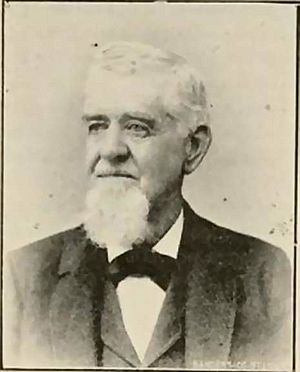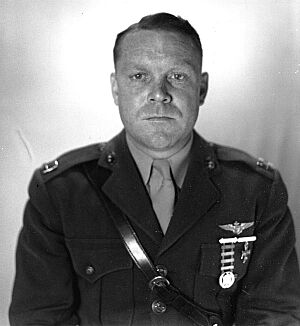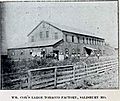Salisbury, Missouri facts for kids
Quick facts for kids
Salisbury, Missouri
|
|
|---|---|

Location of Salisbury, Missouri
|
|
| Country | United States |
| State | Missouri |
| County | Chariton |
| Founded | April 1, 1867 |
| Area | |
| • Total | 1.34 sq mi (3.47 km2) |
| • Land | 1.34 sq mi (3.47 km2) |
| • Water | 0.00 sq mi (0.00 km2) |
| Elevation | 742 ft (226 m) |
| Population
(2020)
|
|
| • Total | 1,563 |
| • Estimate
(2023)
|
1,556 |
| • Density | 1,168.16/sq mi (450.88/km2) |
| Time zone | UTC-6 (Central (CST)) |
| • Summer (DST) | UTC-5 (CDT) |
| ZIP code |
65281
|
| Area code(s) | 660 |
| FIPS code | 29-65450 |
| GNIS feature ID | 2396529 |
Salisbury is a small city in Chariton County, Missouri, United States. It is a friendly community with a rich history. In 2020, about 1,563 people called Salisbury home.
Contents
Discovering Salisbury's Past
The land where Salisbury stands today was first owned by Prier Bibo. He was a soldier in the War of 1812. In 1819, the U.S. government gave him 360 acres of land for his service. Later, in 1856, Judge Lucius Salisbury bought this land for $400.
Judge Salisbury planned the town in 1857. Salisbury was officially founded on April 1, 1867. He also opened the town's first post office in his home in 1863. His business was a stagecoach stop called "Stop-A-While."
Early Challenges and Growth
By 1870, Salisbury had grown to 626 people. However, the town faced some tough times. A big tornado hit Salisbury in 1872. Major fires also damaged the business area in 1877 and again in 1882. Despite these challenges, Salisbury became an official city under Missouri laws on April 4, 1882.
In the late 1800s, Salisbury was a busy place. It had two hotels, a flour mill, and three tobacco factories. There were also many other shops and businesses. The town even had an opera house! Famous performers would visit thanks to the Wabash rail line. By 1896, Salisbury had two newspapers, six doctors, a soda-pop factory, and its own power plant for electricity.
Two important places in Salisbury are listed on the National Register of Historic Places. These are the Salisbury Square Historic District and the Frabrishous and Sarah A. Thomas House.
Learning and Education in Salisbury
The Salisbury R-IV school district provides education for students from kindergarten to 12th grade. This includes students from Salisbury and parts of Chariton County. The school facility had a big update and expansion in 2010 and 2011. This added more classrooms. A new gymnasium and a safe area for tornadoes are also being built.
Salisbury High School's sports teams have won many state championships!
- 1997: Class 1A football
- 2001 and 2002: Class 2A softball
- 2004: Class 1A boys' golf
- 2012: Class 1A girls' cross country
- 2012–2013: Class 2A boys' basketball
The first school in Salisbury opened in April 1867 with 108 students. A fire destroyed this building in 1888. It was replaced by a much larger brick school. Salisbury also had higher education options. Salisbury Academy opened in 1888, offering studies like a junior college. North Missouri Institute, another college-prep school, opened in 1891.
Salisbury also has a public library called the Dulany Memorial Library.
Salisbury's Location and Climate
Salisbury is located where US Route 24 and Missouri Route 129 meet. Keytesville is about seven miles to the west. Clifton Hill is about seven miles to the east. The Middle Fork of the Little Chariton River flows near the southeast side of the city.
The city covers an area of about 1.33 square miles (3.47 square kilometers). All of this area is land.
Weather in Salisbury
| Climate data for Salisbury, Missouri (1991–2020 normals, extremes 1946–present) | |||||||||||||
|---|---|---|---|---|---|---|---|---|---|---|---|---|---|
| Month | Jan | Feb | Mar | Apr | May | Jun | Jul | Aug | Sep | Oct | Nov | Dec | Year |
| Record high °F (°C) | 75 (24) |
81 (27) |
86 (30) |
93 (34) |
97 (36) |
104 (40) |
114 (46) |
107 (42) |
103 (39) |
95 (35) |
82 (28) |
73 (23) |
114 (46) |
| Mean daily maximum °F (°C) | 37.1 (2.8) |
42.5 (5.8) |
53.9 (12.2) |
65.1 (18.4) |
75.0 (23.9) |
83.9 (28.8) |
87.8 (31.0) |
86.7 (30.4) |
80.0 (26.7) |
68.0 (20.0) |
53.9 (12.2) |
41.9 (5.5) |
64.6 (18.1) |
| Daily mean °F (°C) | 27.7 (−2.4) |
32.4 (0.2) |
43.0 (6.1) |
53.8 (12.1) |
64.4 (18.0) |
73.8 (23.2) |
77.4 (25.2) |
75.8 (24.3) |
68.0 (20.0) |
56.0 (13.3) |
43.4 (6.3) |
32.8 (0.4) |
54.0 (12.2) |
| Mean daily minimum °F (°C) | 18.3 (−7.6) |
22.3 (−5.4) |
32.1 (0.1) |
42.6 (5.9) |
53.7 (12.1) |
63.6 (17.6) |
67.1 (19.5) |
64.8 (18.2) |
55.9 (13.3) |
44.0 (6.7) |
32.9 (0.5) |
23.7 (−4.6) |
43.4 (6.3) |
| Record low °F (°C) | −21 (−29) |
−21 (−29) |
−12 (−24) |
15 (−9) |
29 (−2) |
40 (4) |
46 (8) |
36 (2) |
25 (−4) |
20 (−7) |
−8 (−22) |
−28 (−33) |
−28 (−33) |
| Average precipitation inches (mm) | 1.52 (39) |
1.84 (47) |
2.79 (71) |
4.04 (103) |
5.15 (131) |
5.54 (141) |
4.21 (107) |
3.64 (92) |
3.73 (95) |
3.49 (89) |
2.43 (62) |
1.64 (42) |
40.02 (1,017) |
| Average precipitation days (≥ 0.01 in) | 5.3 | 4.8 | 7.5 | 9.6 | 9.8 | 8.5 | 7.9 | 6.6 | 6.2 | 7.3 | 6.1 | 5.5 | 85.1 |
| Source: NOAA | |||||||||||||
Salisbury's Population Over Time
| Historical population | |||
|---|---|---|---|
| Census | Pop. | %± | |
| 1870 | 626 | — | |
| 1880 | 908 | 45.0% | |
| 1890 | 1,672 | 84.1% | |
| 1900 | 1,847 | 10.5% | |
| 1910 | 1,834 | −0.7% | |
| 1920 | 1,757 | −4.2% | |
| 1930 | 1,768 | 0.6% | |
| 1940 | 1,759 | −0.5% | |
| 1950 | 1,676 | −4.7% | |
| 1960 | 1,787 | 6.6% | |
| 1970 | 1,960 | 9.7% | |
| 1980 | 1,975 | 0.8% | |
| 1990 | 1,881 | −4.8% | |
| 2000 | 1,726 | −8.2% | |
| 2010 | 1,618 | −6.3% | |
| 2020 | 1,563 | −3.4% | |
| U.S. Decennial Census | |||
Who Lives in Salisbury? (2010 Census)
In 2010, Salisbury had 1,618 people living in 698 households. Most residents (96.3%) were White. About 2.1% were African American, and 0.5% were Native American. A small number of people were Asian or from other backgrounds.
About 32.1% of households had children under 18. Many households (48.1%) were married couples. The average age in Salisbury was 40.2 years. About 25.4% of residents were under 18 years old.
Famous People from Salisbury
- Floyd B. Parks: He was a brave U.S. Marine pilot. He earned the Navy Cross for his actions during the Battle of Midway. A U.S. Navy destroyer ship, the USS Floyd B. Parks, was named after him.
Fun Things to Do in Salisbury
Salisbury offers several great places for recreation and events.
- Salisbury City Park: This park has a playground, a horse arena, and a tennis court. You can also find a ball field and a picnic area here. The city swimming pool is just across the street.
- James C. Philpotts Park: Located south of the city, this park has a 9-hole public golf course. It also features playgrounds, walking trails, and a small lake. There's even a campground with electricity and water.
- Lakes for Fishing and Boating: Two lakes near the city, Sterling Price Lake and Lake Nehai Tonkayea, are perfect for fishing and boating.
- Salisbury Steak Festival: Held every June, this festival is a big community event. It includes various games, local entertainment, and a delicious community steak supper.
Images for kids
See also
 In Spanish: Salisbury (Misuri) para niños
In Spanish: Salisbury (Misuri) para niños








